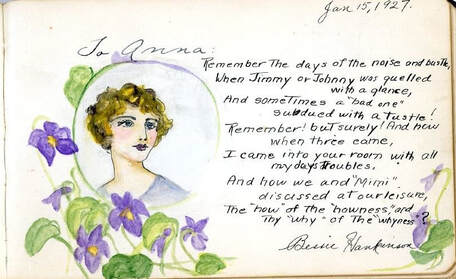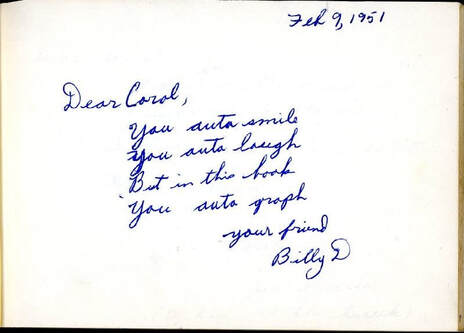These books were quite small in size, usually with a decorative cover, and they were carried around by the owner with the intention of collecting signatures and pieces of writing from their friends and family. The sentiment is similar to how one would sign a yearbook today. Autograph books first appeared in 16th century Europe, carried by travelling university students who wished to have something to remember their friends by. At times it could even be used by scholars to show off any impressive connections they’d made throughout their academic careers. It wasn’t until the nineteenth century that autograph books became more commonplace. Friends and family would write a prayer or wish for the owner of the book, even including a sketch or a painting at times.
Two of these autograph books have recently found their home in our collection- one from years 1925-1928 and the other from 1951. The difference in the language used between the two books is interesting to observe. The 1920’s book generally seems to be more poetic and romantic, but contains its fair share of wit nonetheless. Two gimmicks that appear in both of the books are inscribing “by hook or by crook, I’ll be the first in your book” on the first page, or writing in the book upside-down while including a rhyme about this mischievous act, as shown below.
Another fun word game appears in the 1951 autograph collection, when the writer signs off with “yours till ___”, some creative examples are “yours till Niagra falls”, “yours till the kitchen sinks”, “yours till the barn dances”, and “yours till the washing diapers”. It is unclear where these silly rhymes originated from, possibly from the mind of a creative author one day, and copied from one book to the next ever since. Another interesting aspect is the history represented in these collections. The older autograph book holds many signatures from young members of local pioneer families, names such as Soames, Inglis, Hinsta, Winegarden, and Chamberlin.
It is fascinating to witness the unfiltered humour of past generations. There are many sweet sentiments in these books; however, there are just as many witty and slightly crude remarks. Reading these pages evokes the feeling that despite being separated by several decades, we really aren’t so far apart.













 RSS Feed
RSS Feed
